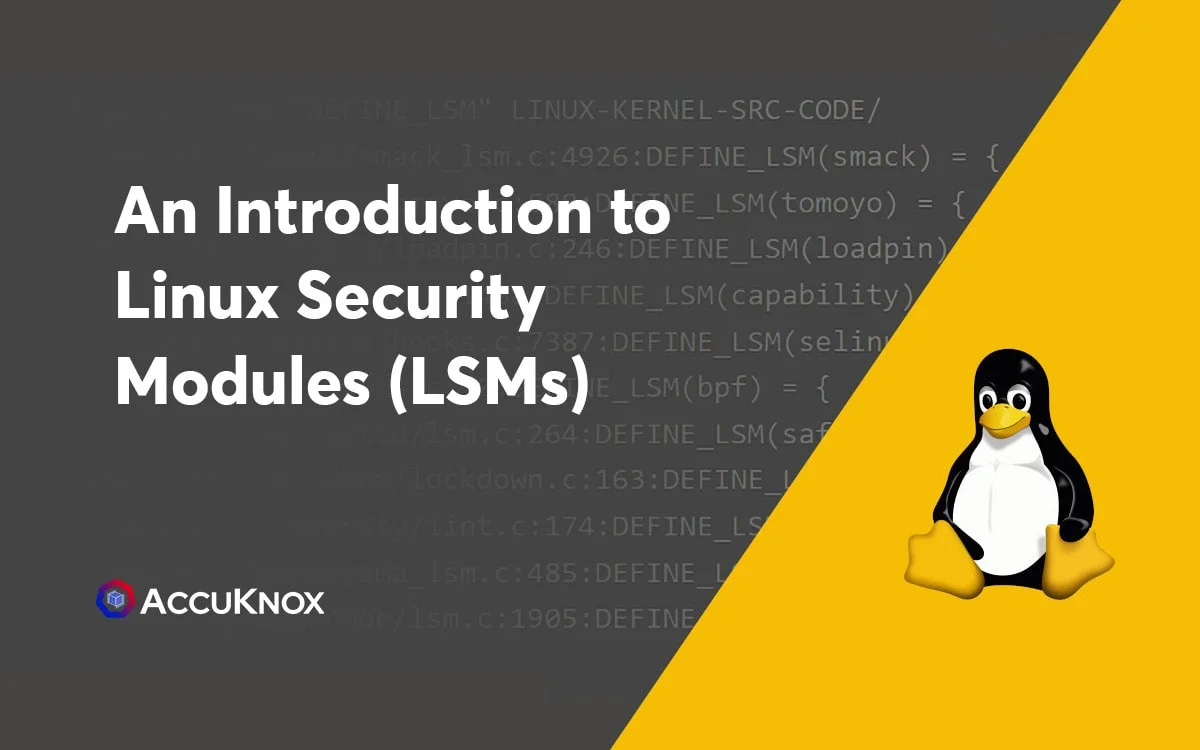
An Introduction to Linux Security Modules (LSMs)
Introduction The Linux security module (LSM) framework, which allows for security extensions to be plugged into the kernel, has been used to implement MAC on Linux. LSM hooks in Linux Kernel mediates access to internal kernel objects such as inodes, tasks, files, devices, and IPC. LSMs, in general, refer to these generic hooks added in […]
Reading Time: 4 minutes
Table of Contents
Introduction
The Linux security module (LSM) framework, which allows for security extensions to be plugged into the kernel, has been used to implement MAC on Linux.
LSM hooks in Linux Kernel mediates access to internal kernel objects such as inodes, tasks, files, devices, and IPC. LSMs, in general, refer to these generic hooks added in the core kernel code. Further, security modules could make use of these generic hooks to implement enhanced access control as independent kernel modules. AppArmor, SELinux, Smack, TOMOYO are examples of such independent kernel security modules.
LSM seeks to allow security modules to answer the question “May a subject S perform a kernel operation OP on an internal kernel object OBJ?”
LSMs can drastically reduce the attack surface of a system if appropriate policies using security modules are implemented.
DACs vs. MACs
DAC (Discretionary Access Control) based access control is a means of restricting access to objects based on the identity of subjects or groups. For decades, Linux only had DAC-based access controls in the form of user and group permissions. One of the problems with DACs is that the primitives are transitive in nature. A user who is a privileged user could create other privileged users, and that user could have access to restricted objects.
With MACs (Mandatory Access Control), the subjects (e.g., users, processes, threads) and objects (e.g., files, sockets, memory segments) each have a set of security attributes. These security attributes are centrally managed through MAC policies. In the case of MAC, the user/group does not make any access decision, but the access decision is managed by security attributes. LSMs are a form of MAC-based controls.
LSM Hooks

LSM hooks are applied after the DAC and other sanity checks are performed.
here it is shown that the LSM hooks are applied in core objects, and these hooks are dereferenced using a global hooks table. These global hooks are added ( e.g., check AppArmor hooks when the security module is initialized.
TOCTOU problem handling
LSMs are typically used for a system’s policy enforcement. One school of thought is that the enforcement can be handled in an asynchronous fashion, i.e., the kernel audit events could pass the alert to userspace, and then the userspace could enforce the decision asynchronously.
Such an approach has several issues, i.e., the asynchronous nature might result in the malicious actor causing the actual damage before the actor could be identified. For example, if the unlink() of a file object is to be blocked, the asynchronous nature might result in the unlink getting successful before the attack could be blocked.
LSM hooks are applied inline to the kernel code processing; the kernel has the security context and other details of the object while making the decision inline. Thus the enforcement is in line with the access attempt, and any blocking/denial action can be performed without TOCTOU problems.
Security Modules currently defined in Linux kernel
LSMs are generic hooks, but if a new security module has to be introduced, the new module can be operated as a kernel module. However, the introduction of a new security module also requires changing the core-kernel code to introduce this module to the kernel. There are already the following modules defined in the default Linux kernel::

In the above list, AppArmor and SELinux are undoubtedly the most widely used. AppArmor is relatively easier to use, but SELinux provides the greater intensive and fine-grained policy specification. Linux POSIX.1e capabilities logic is also implemented as a security module.
There can be multiple security modules used at the same time. This is true in most cases; the capabilities module is always loaded alongside SELinux or any other LSM. The capabilities security module is always ordered first in execution (controlled using .order = LSM_ORDER_FIRST flag).
However, note that AppArmor, SELinux, and Smack security modules initialize themselves as exclusive (LSM_FLAG_EXCLUSIVE) security modules. There cannot be two security modules in the system with the LSM_FLAG_EXCLUSIVE flag set. Thus, this means that one cannot have any two of the following (SELinux, AppArmor, Smack) security modules registered simultaneously.
Permissive hooks in LSMs
Certain POSIX-compliant filesystems depend on the ability to grant accesses that would ordinarily be denied at a coarse level (DAC level) of granularity (check the capabilities man page for CAP_DAC_OVERRIDE). LSM supports DAC override (a.k.a., permissive hooks) for particular objects such as POSIX-compliant filesystems, where the security module can grant access the kernel was about to deny.
Security Modules: A general critique
LSMs, as generic MAC-based security primitives, are very powerful. The security modules allow the administrator to impose additional restrictions on the system to reduce the attack surface. However, if the security module policy specification language is hard to understand/debug, the administrator usually takes a stance of disabling it altogether, thus imposing friction in adoption.
Conclusion
- LSMs are not designed to prevent a process from being attacked.
- Good coding practices, configuration management, and memory-safe languages are the tools for that.
- The protections provided by LSMs do, however, help protect your system from being hacked when an attacker exploits flaws in one of the running programs.
References
- Linux Security Modules: General Security Support for the Linux Kernel, Wright & Cowan et al., 2002
- https://www.kernel.org/doc/html/v5.8/security/lsm.html
All Advanced Attacks are Runtime Attacks
Zero Trust Security
Code to Cloud
AppSec + CloudSec

Prevent attacks before they happen
Schedule 1:1 Demo




